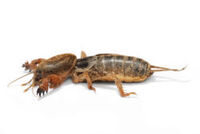- "I caught a mole cricket! I don't see any moles on you, guy!" —Wild World
- "I caught a mole cricket! Proceeding with interrogation!" —City Folk
Mole Crickets can be found during the winter and spring, making a low, repetitive noise underground, from which they can be identified. Players will have to dig in the area in which the noise is loudest. Having been uncovered, the mole cricket will scuttle away. It may jump into water to escape the player.
The mole cricket featured in-game is similar in appearance to Gryllotalpa brachyptera, a mole cricket native to Australia, but it could belong to any of the Gryllotalpidae species.
Upon Donation to the Museum
In Wild World
This section is in need of more information.
==
In City Folk
Blathers will say this when he reluctantly takes the bug:
"As both mole crickets and moles dig holes, it's said many parts of their bodies evolved on similar paths... But the mole is nowhere near as off-putting as this bug... How could they be? Moles don't have antennae."
Further Information

A real-life mole cricket, species Gryllotalpa brachyptera.
Mole crickets can be found throughout the world, specifically in more temperate climates. They are nocturnal and hibernate during the winter. They are rarely seen, as they live underground in tunnel networks, but are nonetheless regarded as pests. They have large forelimbs that can be used to dig and swim. They are roughly three to five centimeters long and are omnivores, meaning they eat both plants and animals. In some areas of Asia they are eaten, but only when fried. Mole Crickets also feature as a character in another of Nintendo's games - Mother 3.
